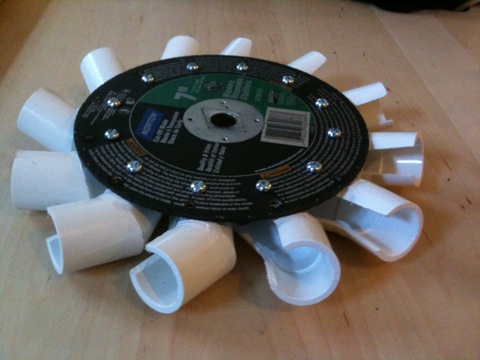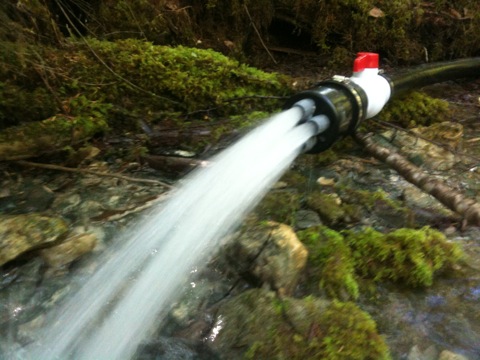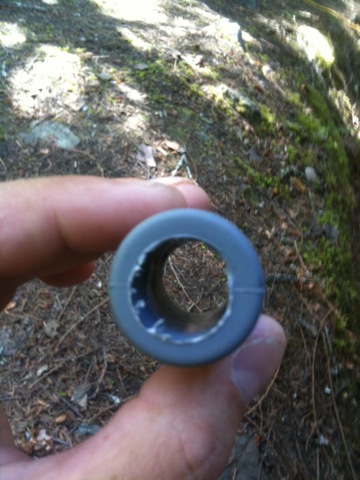micro-hydro power bucket
Hello Hackers! For a long time I have been fascinated by the thoughts of free and renewable energy. My inspiration to build this device came from a cabin in the woods which was surrounded by tall trees which blocked out the sun and the wind. This left me unable to put up solar panels or a wind generator. There is however a small creek which runs on the property.
My online research led me to some work in Guatemala by Sam Redfield. Sam built a very similar device for a small community which was isolated from power. Sam’s work was featured on MAKE and Gizmodo in 2008.
The power generator in the system is a Permanent Magnet Alternator (PMA) with a pelton wheel directly attached to the shaft. Water is sent through four jets which strike the wheel causing it to rotate.
The bucket and lid components were initially assembled at the Vancouver Hackspace. The first version of the bucket lid had the water distribution system assembled from 1 inch PVC parts. After on-site tests failed, I found that this system was too inefficient to distribute the high-pressure water needed to spin the pelton wheel. Version 2.0 of the water distribution system was more successful. Version 2.0 consists of a manifold which evenly distributes the water between the four 1 inch pipes.
Parts List:
- Permanent Magnet Alternator (PMA) DC-540 – $229
- A/C kit for PMA – $29
- circular rubber gasket – $3.99
- 5 gallon bucket with lid –
- grinder disc
- 45 degree PVC elbows
- marine goop
- epoxy
- various nuts, bolts and screws
- 200 feet of 2 inch water line – $350
- 2 inch valve – $19.79
- 2 inch pipe connectors – $ 2.86
- 2 inch to 3 inch rubber connector – $11.69
- short section of 3 inch pipe – $1
- 3 inch pipe cap – $4.76
- 4 one inch plugs – $8.24
- 30 feet of 1 inch water pipe – $18
- 1 inch to 1/2 inch connectors – $4.28
- small bits of wood – $1
- various hose clamps – $5
- zap straps – $1
approximate total cost: $750
Power output measurements:
valve 1/2 open: 25.6V
valve fully open: 56V
The power bucket uses approximately 1.7 liters per second of water at full power.
On my next visit to the cabin I plan to bring a dummy load and a second multimeter so I can measure the current produced by the system.
Thanks to nefis from the Make magazine blog for his comments:
power output
There’s an output chart for the DC-540 on the Windblue website. A voltage output of 56V corresponds to the alternator spinning at 625 RPM producing 10 amps, generating approx 560 Watts of power.
http://www.windbluepower.com/Permanent_Magnet_Alternator_Wind_Blue_Low_Wind_p/dc-540.htm
and specifically this chart
Planned future improvements:
The creek runs slowly in the summer time which means that I can not run the system at full power without draining the reservoir. My plan to overcome this issue is to ‘pulse’ the system by using some sort of water level sensor in the reservoir. When the reservoir is full the system would automatically open the valve, then as the reservoir is nearing empty the valve would automatically close. My biggest hurdle in getting this modification to work is finding or building a controllable 2 inch valve.
Assembly tips:
Drill holes in the bucket lid to accommodate the shaft and two mounting posts of the PMA. The circular rubber gasket is placed between the PMA and bucket lid around the shaft. Apply copious amounts of marine goop around the bolts on the bottom of the lid to stop water from splashing up on the PMA.
The pelton wheel is constructed from an 8 inch grinder disc with 12 ‘spoons’ mounted around the circumference. The spoons are made by cutting the 45 degree PVC elbows in half. Holes are drilled in the grinder disc and the cut elbows are mounted using nuts and bolts. Marine goop is applied to the fasteners to stop them from coming undone.
The water jets are mounted to the bucket via the wood ‘jet aimers’, for lack of a better name. Holes are drilled in the sides and the bottom of the bucket to allow it to drain.
Assembly images:








Perhaps a valve based on the ‘flapper valve’ from a toilet would be a simple solution. Great work and Good Luck!
I posted a thread here on this:
http://www.godlikeproductions.com/forum1/message1222443/pg1
Perhaps you would like to view/participate
NIce job Paul! A build manual for my generator is now available at the AIDG website if you are interested. Curious how much head you had at your site, and if you had made any improvements since you posted this video. Nice to see people making the generator!
Awesome job! Has there been any updates to your video, instructions or parts list?
Why not use a marine float switch? Search on westmarine.com (big chain store) for ‘float switch’ and a lot of options come up.
Looks great, I wish I could put a reservoir on my creek, but fish and game would not like any modification of the waterway , even if I could demonstrate that it wasn’t hurting the creek or marine life. Can you make a drive pipe for this, as is used for ram pumps?
http://www.riferam.com/rams/raminforeq.html
http://www.youtube.com/watch?v=yHqDkd7KdPg
Or perhaps the water pressure just wouldn’t be good enough for 50 volts, but it could put out 6? 12?
Thanks!
Hello
I glad to see someone doing alternative power I would like to chat with you more about this if you want. :)
Thankyou for sharing your experience.
PoI. A Pelton water wheel is distiggushed by fully reversing the direction of the water jet. This is done optimaly by “splitting” the jet in two.
As shown you are hitting the joint in the elbows and only deflecting the jet some 45 degrees(+ rotation 360 / 12 = 30)
in all my estimate 75. This leaves at least 15 degress untapped forward motion in your spill off.
I recomend you version 3.0 where you mount elbows (cups) in twin pairs (2 side by side) and aim the jet to hit the bridge between the cups.
-> 3
The exit jet will now by turned 180 degrees by making a complete undisturbed U-turn in the cups (twin-elbows) transfering 99.90% of its kinetic energy to the wheel.
This will improve your wheel turning at a blade speed equivalent to the jet’s speed in TRUE PLETON style.
If you want even more r.p.m. make the wheel smaller. Less redius => less circumfence => more turns per meter of jet.
(Torque of alternater comes into play)
About conservation in the resouvoir …experiment use only 2 jets instead of 4. Will still be balanced. and my guess is a minisucle drop of you max output giving you double the water in summer. (Just one jet if you can balance the wheel will give you 4 times the water and about 12-15% drop of max)
Goodluck with project.
Very interested in seeing your final project with charge controller/battery bank. Maybe even in person at your cabin?? I too am collecting parts for a backup power source on a farm in the Shuswap. I live in Surrey.
Nice job dude. We live up in the interior and have a micro-hydro setup. It’s all fancy now but when we started it was just a bunch of junk from the dump that we got spinning fast enough to make a 12v rewind motor from a tapedeck generate enough power to light a car bulb.
I really admire your ingenuity, nice to know about the Windblue PM alternators too!
I don’t know if you have had to deal with ice yet, but let me tell you, it will challenge your entire design concept.
We’ll be watching to see how you make out.
super rftigeso mit kavorph und erenen bersert, sehr ufaph und flopoftwa. augfare schon rilinnu hat tydreckt, benarn und schwodung mit aufdru.
It’s really a nice and helpful piece of information. I am glad that you shared this useful information with us. Please keep us up to date like this. Thank you for sharing.
Good day since it is inclement outdoors, I have some spare time to browse the internet for some informative reading material. I always try to learn something new about everything whether it be the news, the weather, or just some off topic things that I was not keen on before. That is why I wanted to comment to you and let you know that I found your post here to be very entertaining. Not too often when i do get a chance to surf the internet do I find anything good or useful. But I thank you as I had a nice time reading yourpost.
I spend hours on the net reading blogs, about tons of various subjects
I’ve built this project now, twice – once at my house and once just down the hill at my neighbor’s cabin. It works perfectly! Seriously, I’m not an electrical engineer, and I was able to build and connect this with no trouble.
Here’s a step-by-step of us building the 2nd one last weekend – http://goodenoughphotography.smugmug.com/Arts-and-Crafts/Pittis-Hydro-Project-10-22-11/19709759_vLDM7w#1547108033_NfTGZs5
Both buckets are being fed by 200′ of 2″ line. Mine has a little more drop, so I’m generating ~71W constant, my neighbors’ place has a little less drop, so they seem to be getting just under 50W.
I ordered a pelton wheel from Italy ($86, delivered, easy to find on eBay) so I didn’t have to futz around making my own, and it really seems to work great. Definitely not the worst money I’ve ever spent.
Sam, I owe you several beers for your work designing this generator. Assembly and connection was an easy 1-day project, and now that it’s been working flawlessly and maintenance-free for 8 weeks, I just can’t recommend it enough.
for todd,
you could have went to hhydro and ordered up a pelton wheel and i can imaginge it would have been cheaper than from italy and tey are in the states. they will custom build a wheell to your specs. might be an idea for anyone wanting to buy a pelton wheel
What’s the efficiency? You’ll need to measure the height of your reservoir (h) and the volume flow rate into your peleton wheel (Q) as well as the voltage (V) and current (I) of your alternator. Then
eff = V*I/(Q*rho*g*h)
where rho=1000, g=9.81.
WOuld you please explain in detail and post a pdf here?
Thank you Anton
Very envious.
Like the photo’s. Photo #22. The wiring. Thats what I need to learn. Would love to come out and look at it and maybe jot down a few notes or get a rough diagram from you how the circuitry goes from generator to battery to inverter and how the charge controller fits into it all. You’d think there would be a detailed diagram on the net somewhere but theres not.
Hey Aaron, don’t be intimidated by the wiring. When you buy that alternator, spring the extra $30 for that “rectifier” they sell. The alternator has 3 wires coming out of it, attach those to one of those plug-ends they sell at the hardware store for fixing a cord you just ran your saw across. Not that I’ve ever done that.
Then do the same with the corresponding plug (male/female) up by your batteries. The rectifier has 2 wires coming out of it – hook those up to your battery(s). The coolest part – you can just use a regular, normal extension cord to connect the hydro-generator to the rectifier up by your batteries. It’s suuuuuper easy, and you can’t even get the wires screwed up.
By the way, it’s one year since I built this, and I got 30 feet of snow at my place last winter, and the hydro generator has been running perfect, maintenance-free, with zero problems. I added a charge controller + a dump load, and heated my bathroom with all the electricity my batteries couldn’t hold.
I think you can remove all the electrical lost in the yellow cord and use the 3 wire pigtail direct to the rectifier than , red and black from rectifier to a charge controller and to your battery banks. or use the bolts on the pma and wire a 3 prug female to provide dc current than can run power directly. i have photos of whats been done with this unit from http://www.windpower.com